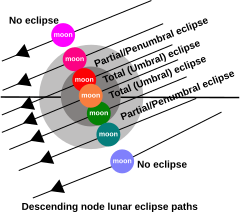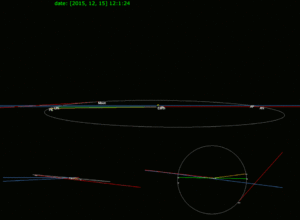Saros (astronomy) facts for kids
The saros is a special time period that helps scientists predict when eclipses of the Sun and Moon will happen. It lasts for about 18 years, 10, 11, or 12 days, plus 8 hours. After one saros period, the Sun, Earth, and Moon return to almost the same positions in space. This means a very similar eclipse will happen again. This repeating pattern is called an eclipse cycle. A sar is half of a saros.
When eclipses are separated by one saros, they form a saros series. This period is equal to:
- 6,585 days (a little over 18 years)
- 223 synodic months (the time it takes for the Moon to go through all its phases, like new moon to new moon)
- 242 draconic months (the time it takes for the Moon to return to the same point where its path crosses Earth's path around the Sun)
- 239 anomalistic months (the time it takes for the Moon to return to its closest point to Earth)
Because the saros is almost 19 eclipse years long, if a solar eclipse or lunar eclipse happens, then after one saros, a new moon will occur at the same node (where the Moon's orbit crosses Earth's orbit). This allows another eclipse to happen.
Contents
History of the Saros
The idea of the saros was first discovered by ancient Babylonian astronomers many centuries before Christ. Later, famous Greek thinkers like Hipparchus and Ptolemy also knew about it.
The name "saros" comes from a Greek word. It was given to this eclipse cycle by Edmond Halley in 1686. He found the word in an old book from the 11th century called the Suda. This book said that "saros" was a measurement used by the Chaldeans (another name for Babylonians). The Greek word might come from a Babylonian word "sāru," which means the number 3600. It could also come from a Greek verb meaning "to sweep," perhaps referring to how eclipses seem to sweep across the sky.

The number 223 lunar months, which is the length of the Saros period, is written on the Antikythera Mechanism. This amazing ancient Greek device was built around 150 to 100 BC. It was like an ancient computer used to track the movements of the Sun, Moon, and planets, and to predict eclipses. You can still see this number on the mechanism today.
What is the Saros?
The saros period is 6585.3211 days long. This is about 18 years and 10, 11, or 12 days, depending on how many leap years are included. This period is super useful for predicting when almost identical eclipses will happen again.
For an eclipse to occur, the Sun, Earth, and Moon must line up.
- For a solar eclipse, the Moon must be between the Earth and the Sun (this happens during a new moon).
- For a lunar eclipse, the Earth must be between the Sun and the Moon (this happens during a full moon).
These alignments happen only when the Moon is near one of its two nodes. These are the points where the Moon's orbit crosses the Earth's orbit around the Sun.
The saros works because three important cycles of the Moon's orbit almost perfectly match up:
- The synodic month (about 29.5 days) is the time from one new moon to the next.
- The draconic month (about 27.2 days) is the time it takes for the Moon to return to the same node.
- The anomalistic month (about 27.5 days) is the time it takes for the Moon to return to its closest point to Earth.
After one saros, the Moon has completed almost a whole number of these cycles. This means the Earth-Sun-Moon lineup will be almost exactly the same. The Moon will be in the same phase (new or full), at the same node, and at the same distance from Earth. Also, because a saros is close to 18 years, the Earth will be at nearly the same spot in its orbit around the Sun, and tilted in the same way (meaning it's the same season).
Since the saros is not an exact number of days (it has an extra 8 hours), each eclipse in a saros series happens about eight hours later in the day. For a solar eclipse, this means the eclipse will be visible from a different part of the world, shifted about one-third of the way around the globe. For a lunar eclipse, it might still be visible from the same place if the Moon is above the horizon. If you wait for three saros periods (about 54 years), an eclipse will happen at nearly the same local time of day. This three-saros period is called a triple saros or exeligmos.
Saros Series
Every saros series begins with a small partial eclipse. As time goes on, each eclipse in the series shifts slightly. This shift happens because the saros is not an exact number of draconic months. Eventually, the eclipses are no longer possible, and the series ends.
Scientists have given numbers to different saros series. There are separate series for solar and lunar eclipses. At any given time, about 40 different saros series are active.
A saros series can last a very long time, between 1226 and 1550 years. During this time, a series can have anywhere from 69 to 87 eclipses. Most series have 71 or 72 eclipses. Many of these will be "central" eclipses, meaning they are total, annular, or hybrid.
Example of a Saros Series
Let's look at lunar saros series 131 as an example. This series started in the year 1427 with a small partial lunar eclipse. Over time, the Moon's path shifted, and the first total lunar eclipse in this series happened in 1950. For the next 252 years, total eclipses will occur. The most central eclipse in this series will happen in 2078. After that, the eclipses will become partial again, with the final partial eclipse of this series happening in 2707. The entire life of lunar saros series 131 is 1280 years.
Because of the extra 8 hours in a saros, the visibility of each eclipse in a series changes for people on Earth. For example, the total lunar eclipse in saros series 131 in 1950 was best seen in Eastern Europe and the Middle East. The next eclipse in the series, in 1968, happened about 8 hours later and was best seen from North and South America. The third total eclipse in 1986 was best seen from the Western Pacific, East Asia, Australia, and New Zealand. This pattern of visibility repeats throughout the series.
Sar: Half a Saros
After a solar or lunar eclipse, if you wait 9 years and about 5 and a half days (which is half a saros, or a sar), a different type of eclipse will happen with similar features.
For example, if a solar eclipse happens where the Moon's faint shadow (penumbra) just barely touches the southern edge of the Earth, then 9 years and about 5 and a half days later, a lunar eclipse will occur where the Moon is partially covered by the southern edge of Earth's faint shadow. Similarly, after a total or annular solar eclipse, a total lunar eclipse will happen 9 years and 5 and a half days later. This 9-year period is called a sar. It includes 111 and a half synodic months. The "half" month means it switches between solar and lunar eclipses.
See also
 In Spanish: Saros para niños
In Spanish: Saros para niños
- List of saros series for lunar eclipses
- Eclipse cycle
- Solar eclipse
- Lunar eclipse
- Metonic cycle




